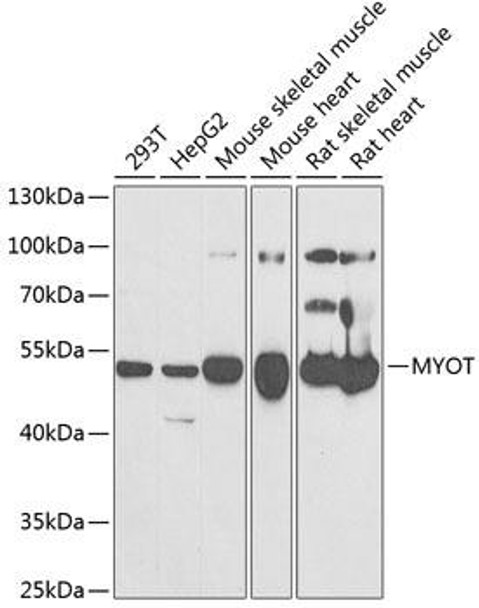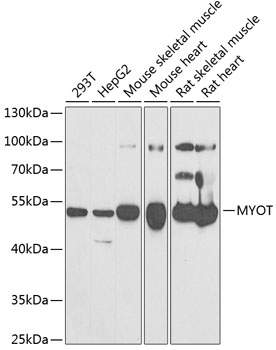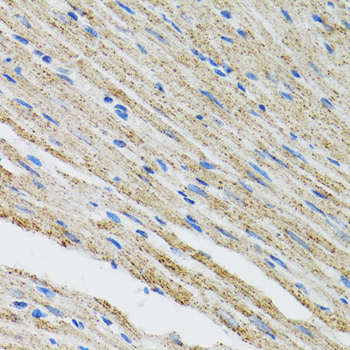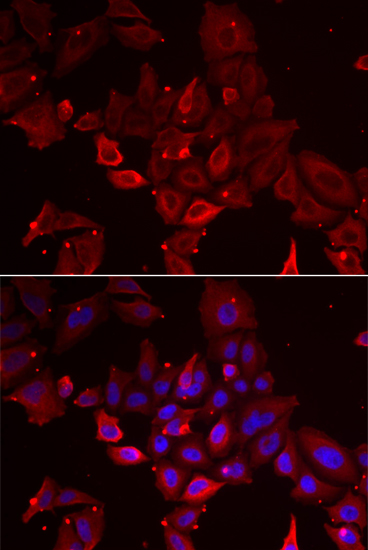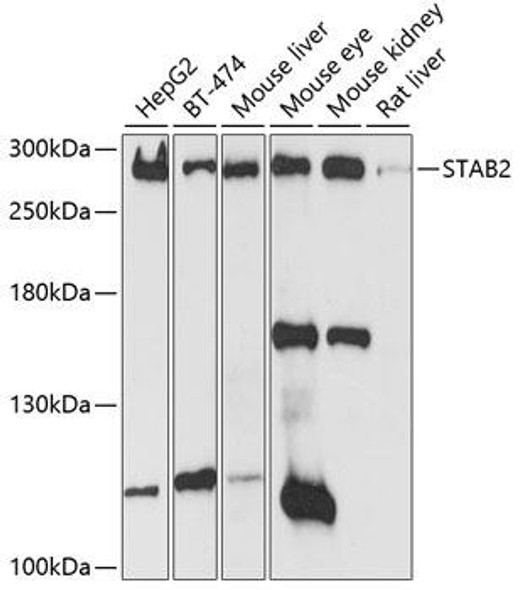Anti-MYOT Antibody (CAB6439)
- SKU:
- CAB6439
- Product type:
- Antibody
- Reactivity:
- Human
- Mouse
- Rat
- Host Species:
- Rabbit
- Isotype:
- IgG
- Antibody Type:
- Polyclonal Antibody
- Research Area:
- Cell Biology
Frequently bought together:
Description
| Antibody Name: | Anti-MYOT Antibody |
| Antibody SKU: | CAB6439 |
| Antibody Size: | 20uL, 50uL, 100uL |
| Application: | WB IHC IF |
| Reactivity: | Human, Mouse, Rat |
| Host Species: | Rabbit |
| Immunogen: | Recombinant fusion protein containing a sequence corresponding to amino acids 259-314 of human MYOT (NP_001129412.1). |
| Application: | WB IHC IF |
| Recommended Dilution: | WB 1:500 - 1:2000 IHC 1:50 - 1:200 IF 1:10 - 1:100 |
| Reactivity: | Human, Mouse, Rat |
| Positive Samples: | 293T, HepG2, Mouse skeletal muscle, Mouse heart, Rat skeletal muscle, Rat heart |
| Immunogen: | Recombinant fusion protein containing a sequence corresponding to amino acids 259-314 of human MYOT (NP_001129412.1). |
| Purification Method: | Affinity purification |
| Storage Buffer: | Store at -20°C. Avoid freeze / thaw cycles. Buffer: PBS with 0.02% sodium azide, 50% glycerol, pH7.3. |
| Isotype: | IgG |
| Sequence: | RPNQ TLPA PKQL RVRP TFSK YLAL NGKG LNVK QAFN PEGE FQRL AAQS GLYE SEEL |
| Gene ID: | 9499 |
| Uniprot: | Q9UBF9 |
| Cellular Location: | Cell membrane, Cytoplasm, Z line, cytoskeleton, myofibril, sarcolemma, sarcomere |
| Calculated MW: | 35kDa/55kDa |
| Observed MW: | 55kDa |
| Synonyms: | MYOT, LGMD1, LGMD1A, MFM3, TTID, TTOD, myotilin |
| Background: | This gene encodes a cystoskeletal protein which plays a significant role in the stability of thin filaments during muscle contraction. This protein binds F-actin, crosslinks actin filaments, and prevents latrunculin A-induced filament disassembly. Mutations in this gene have been associated with limb-girdle muscular dystrophy and myofibrillar myopathies. Several alternatively spliced transcript variants of this gene have been described, but the full-length nature of some of these variants has not been determined. |
| UniProt Protein Function: | MYOT: Component of a complex of multiple actin cross-linking proteins. Involved in the control of myofibril assembly and stability at the Z lines in muscle cells. Defects in MYOT are the cause of limb-girdle muscular dystrophy type 1A (LGMD1A). LGMD1A is an autosomal dominant degenerative myopathy with onset within a mean age of 28 years. LGMD1A is characterized by progressive skeletal muscle weakness of the hip and shoulder girdles, later progressing to include distal weakness, as well as a distinctive dysarthric pattern of speech. Affected muscle exhibits disorganization and streaming of the Z-line. Defects in MYOT are the cause of myopathy myofibrillar type 3 (MFM3). A neuromuscular disorder characterized by progressive skeletal muscle weakness greater distally than proximally, tight heel cords, hyporeflexia, cardiomyopathy and peripheral neuropathy in some patients. Affected muscle exhibits disorganization and streaming of the Z-line, presence of large hyaline structures, excessive accumulation of myotilin and other ectopically expressed proteins and prominent congophilic deposits. Defects in MYOT are the cause of spheroid body myopathy (SBM). SBM is an autosomal dominant form of myofibrillar myopathy (MFM), characterized by slowly progressing proximal muscle weakness and dysarthric nasal speech. There is no evidence of cardiomyopathy. Muscle biopsy shows spheroid bodies within the type I muscle fibers. Belongs to the myotilin/palladin family. 2 isoforms of the human protein are produced by alternative splicing. |
| UniProt Protein Details: | Protein type:Cytoskeletal Chromosomal Location of Human Ortholog: 5q31 Cellular Component: Z disc; sarcolemma; actin cytoskeleton Molecular Function:protein binding; structural constituent of muscle; alpha-actinin binding; actin binding Biological Process: muscle contraction Disease: Myopathy, Spheroid Body; Muscular Dystrophy, Limb-girdle, Type 1a; Myopathy, Myofibrillar, 3 |
| NCBI Summary: | This gene encodes a cystoskeletal protein which plays a significant role in the stability of thin filaments during muscle contraction. This protein binds F-actin, crosslinks actin filaments, and prevents latrunculin A-induced filament disassembly. Mutations in this gene have been associated with limb-girdle muscular dystrophy and myofibrillar myopathies. Several alternatively spliced transcript variants of this gene have been described, but the full-length nature of some of these variants has not been determined.[provided by RefSeq, Oct 2008] |
| UniProt Code: | Q9UBF9 |
| NCBI GenInfo Identifier: | 311033402 |
| NCBI Gene ID: | 9499 |
| NCBI Accession: | Q9UBF9.2 |
| UniProt Secondary Accession: | Q9UBF9,A0A4R6, B4DT79, |
| UniProt Related Accession: | Q9UBF9 |
| Molecular Weight: | 498 |
| NCBI Full Name: | Myotilin |
| NCBI Synonym Full Names: | myotilin |
| NCBI Official Symbol: | MYOT |
| NCBI Official Synonym Symbols: | MFM3; TTID; TTOD; LGMD1; LGMD1A |
| NCBI Protein Information: | myotilin; 57 kDa cytoskeletal protein; myofibrillar titin-like Ig domains protein; titin immunoglobulin domain protein (myotilin) |
| UniProt Protein Name: | Myotilin |
| UniProt Synonym Protein Names: | 57 kDa cytoskeletal protein; Myofibrillar titin-like Ig domains protein; Titin immunoglobulin domain protein |
| Protein Family: | Myotilin |
| UniProt Gene Name: | MYOT |
| UniProt Entry Name: | MYOTI_HUMAN |

